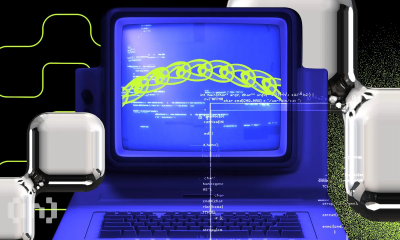Market
Decentralized Masters and Their DeFi Journey


Decentralized finance (DeFi) scene is growing quickly. Tan Gera and Salim Elhila and have entered this dynamic field, starting Decentralized Masters, a platform to guide and teach people about the crypto world.
The entrepreneur duo’s journey shows their ability to adapt, overcome, and evolve, as they create a space for themselves in DeFi’s changing environment.
Decentralized Masters is a platform designed to educate and guide individuals in the DeFi space. It offers comprehensive resources and strategies for navigating the crypto industry, covering everything from portfolio management to market analysis. The platform fosters a mastermind community, bringing together high-value individuals to share insights and strategies. Decentralized Masters aims to bridge the gap between traditional finance and the emerging DeFi world, equipping members with the knowledge and tools to succeed.
From Wall Street to Web3
Salim, an AI and big data engineer by trade, found his calling beyond the corporate world. With a background in engineering, mathematics, and statistical modeling, he expanded his expertise to include marketing and sales strategies for online ventures, becoming the marketing mastermind behind a combined $100M in sales in these industries.Yet, his real breakthrough came in 2022 when a tweet by Elon Musk sparked his interest in Bitcoin (BTC), propelling him down the cryptocurrency rabbit hole.
“I participated in many Web3 projects, the most famous being MetaLegends, where I was managing the marketing side of things. This project sold out for $20 million. That’s when I realized things are happening way faster in the Web3 world”, Salim says. “And by that time, I met Tan. At the peak of the last bull market we chose to launch something together. And that’s how Decentralized Masters came to be.”
Tan, on the other hand, began his journey in the world of finance, climbing the investment banking ladder. From the suburbs of Paris, he navigated a traditional path, securing a role on Wall Street, where he witnessed the inner workings of the banking industry. But Tan’s experience with crypto conferences and witnessing the potential of blockchain technology led him to shift gears. He recognized the power of DeFi, particularly in comparison to traditional banking systems, and made the transition to the crypto space.
“At 21 I passed my CFP1 and got access to Wall Street. I did an internship there as an investment banker, and it really opened my eyes,” Tan adds. “I saw behind the curtains of the big investment banks how the game was rigged. And I saw true use cases of crypto, how it could make everything better.”
Turning Adversity into Opportunity
The inception of Decentralized Masters came at a crucial moment. The company launched just before a brutal market crash: one of the biggest centralized exchanges in the US, FTX, collapsed, triggering a domino effect throughout the industry. The downfall of Sam Bankman-Fried’s empire led to widespread fear, eroded trust in CEXes and intensified the challenges for a freshly launched company.
Despite early success, their journey took a steep turn when their payment processor unexpectedly blocked transactions and banking partners temporarily froze funds. Plus, social platforms restricted their content and it was as if everyone was against them. However, Salim and Tan saw an opportunity in the adversity.
“We were starting to sell really well. It was a massive success. But after one or two weeks of sales, the FTX crash happened,” – Salim reflects. “And from there, everything went downhill. We almost gave up, it felt like the whole Universe was conspiring to make sure we wouldn’t win. But by the end of the year we were like – you know what, if we manage to do this during a bear market, imagine how amazing it will be during a bull market? And from there, it has been a crazy ascension.”
The duo’s resilience paid off, as they secured new banking partners and payment processors, and Decentralized Masters grew from zero employees by the end of 2022 to over 80 team members in just a year.
Both entrepreneurs now look back to late November 2022 as a turning point for the whole DeFi space. People recognized that centralized exchanges were not safe and reaffirmed the value proposition of DeFi platforms.
Tan notes centralized exchanges function like traditional banks, using clients’ assets to make money and offering crypto products without leveraging blockchain technology. According to him, this leads to issues such as limited transparency and lack of security, as seen in the FTX case.
“What centralized exchanges do? They pay clients 3-4% and use their crypto to make 20-30-40% in DeFi protocols. That’s exactly what the bank does when you leave your money in savings,” he recalls. “What we want to teach people is to self-custody their funds to hedge against the monetary system, so they can control it and make the profit instead of giving it to the third party.”
The Decentralized Approach
Decentralized Masters provides comprehensive education on DeFi and crypto markets. The platform’s value lies in its multifaceted approach, from portfolio management and asset selection to technical analysis and strategy development.
As for now, the company boasts a team of 10 full-time analysts who conduct in-depth research into various projects, comparing them across a range of variables. They provide a full overview of each asset, incorporating fundamental, technical, on-chain, and team analyses. The projects are then graded based on these variables, resulting in a ranking system to assess their success potential.
“We’re lucky to be surrounded by a team of people who are all experts in their different narratives. They conduct due diligence on a daily basis,” Tan explains. “That allows us to basically rate different protocols, different projects, and make sure that we only invest in projects that have a high potential of staying alive.”
But the team’s vision extends beyond analysis, encompassing community building and mentoring. Decentralized Masters offers a mastermind community and a platform for members to connect and share knowledge. This extensive ecosystem has fostered a thriving community, where members proudly display their credentials.
“We gather high-value individuals with the same sophistication and values,” Salim notes. “Сommunity in crypto is everything: it can make or break one’s success. At the end of the day, when you’re surrounded by the right people, things tend to work pretty well.”
Bridging TradFi and DeFi
Decentralized Masters’ narrative was designed to act as a bridge between traditional finance (TradFi) and DeFi. Their strategies leverage portfolio management principles from Tan’s CFA background, while also incorporating decentralized finance tools. This convergence of two worlds is pivotal to their mission.
“We teach people to stay away from risk while optimizing potential rewards. It’s all about the portfolio allocation principles that we have and the rules that we follow to make sure we avoid the downside,” Salim comments. “Once you have decided which 10 to 12 assets you want to hold, you can use DeFi tools to juice up the returns with a long term mindset. When the market is going red, you can add some delta-neutral strategies and more elaborate strategies on top.”
The founders draw a parallel from the TradFi world to the current DeFi space, where concepts such as restaking and liquid restaking echo the derivatives ideology from traditional finance. They highlight that this transition represents a broader shift, with all the innovation from TradFi moving to DeFi, where everything can be tokenized.
“While TradFi currently holds more capabilities due to decades of development, DeFi is quickly catching up, particularly with finance experts joining the pace. This space needs real finance people to jump ship and help the devs,» Tan asserts, highlighting the need for collaboration between financial and technical expertise.
This union is embodied in the Decentralized Masters team, with Salim’s engineering prowess and Tan’s finance acumen driving the platform’s growth. The project is poised to expand further, led by its dedication to education, innovation, and community building. Decentralized Masters’ vision reflects the evolving crypto space, as they merge the old and new financial worlds, offering nuanced insights and strategies.
Disclaimer
In compliance with the Trust Project guidelines, this opinion article presents the author’s perspective and may not necessarily reflect the views of BeInCrypto. BeInCrypto remains committed to transparent reporting and upholding the highest standards of journalism. Readers are advised to verify information independently and consult with a professional before making decisions based on this content. Please note that our Terms and Conditions, Privacy Policy, and Disclaimers have been updated.
Market
Report Alleges Massive Meme Coin Sniping on Pump.fun

According to a new report from Pine Analytics, token deployers on Pump.fun systematically funded sniper wallets to buy their own meme coins. This impacted over 15,000 token launches on the platform.
These sniper wallets operated primarily during US trading hours, executing standardized, profitable strategies. Unrelated bot activity obscures their behavior, making it extremely difficult to isolate these wallets—and they can readily adapt to new countermeasures.
Snipers Roam Free on Pump.fun Meme Coins
Pump.fun has remained one of the most popular meme coin launchpads on Solana despite persistent controversies and other criticism.
However, Pine Analytics’ new report has uncovered a new controversy, discovering systematic market manipulation on the platform. These snipes include as much as 1.75% of all launch activity on Pump.fun.
“Our analysis reveals that this tactic is not rare or fringe — over the past month alone, more than 15,000 SOL in realized profit was extracted through this method, across 15,000+ launches involving 4,600+ sniper wallets and 10,400+ deployers. These wallets demonstrate unusually high success rates (87% of snipes were profitable), clean exits, and structured operational patterns,” it claimed.
Solana meme coin deployers on Pump.fun follow a consistent pattern. They fund one or more sniper wallets and grant them advance notice of upcoming token launches.
Those wallets purchase tokens in the very first block and then liquidate almost immediately—85% within five minutes and 90% in just one or two swap events.

Pump.fun meme coin developers exploit this tactic to create the appearance of immediate demand for their tokens. Retail investors, unaware of the prior sell‑off, often purchase these tokens after the snipe, giving developers an unfair advantage. This constitutes market manipulation and erodes trust in the platform.
Pine Analytics had to carefully calibrate its methods to identify genuine snipers. Apparently, 50% of meme coin launches on Pump.fun involve sniping, but most of this is probably bots using the “spray and pray” method.
However, by filtering out snipers with no direct links to developer wallets, the firm missed projects that covered their tracks through proxies and burners.
In other words, the meme coin community does not have adequate defenses against systematic abuse on Pump.fun. There are a few possible ways that the platform could flag repeat offenders and sketchy projects, but adaptive countermeasures could defeat them. This problem demands persistent and proactive action.
Unfortunately, it may be difficult to enact such policies. Meme coin sniping is so systematic that Pump.fun could only fight it with real commitment.
Analysts think that building an on-chain culture that rewards transparency over extraction is the best long-term solution. A shift like that would be truly seismic, and the meme coin sector might not survive it.
Disclaimer
In adherence to the Trust Project guidelines, BeInCrypto is committed to unbiased, transparent reporting. This news article aims to provide accurate, timely information. However, readers are advised to verify facts independently and consult with a professional before making any decisions based on this content. Please note that our Terms and Conditions, Privacy Policy, and Disclaimers have been updated.
Market
Solana Leads Blockchain Metrics as SOL Momentum Builds

Solana (SOL) continues to show strength across multiple fronts, maintaining a bullish structure on its Ichimoku Cloud chart while gaining momentum in key market metrics. The BBTrend indicator has turned higher again, signaling renewed buying pressure after a brief cooldown.
On-chain activity remains strong, with Solana leading all blockchains in DEX volume and dominating fee generation thanks to the explosive growth of meme coins and launchpad activity. With SOL now trading above a key resistance level, the path is open for further upside—though a loss of momentum could still trigger a retest of lower supports.
Solana Maintains Bullish Structure, but Momentum Faces Key Test
On Solana’s Ichimoku Cloud chart, the price is currently above the Kijun-sen (red base line) but has dipped below the Tenkan-sen (blue conversion line), signaling weakening short-term momentum.
The flattening Tenkan-sen and price behavior suggest possible consolidation or the early stages of a pullback. Still, with the price holding above the Kijun-sen, medium-term support remains intact.

The overall Ichimoku structure remains bullish, with a thick, rising cloud and leading span A well above span B—indicating strong underlying support.
If Solana finds support at the Kijun-sen and climbs back above the Tenkan-sen, the uptrend could regain strength; otherwise, a test of the cloud’s upper boundary may follow.

Meanwhile, Solana’s BBTrend is currently at 6, extending nearly ten days in positive territory after peaking at 17.5 on April 14. The recent increase from 4.26 to 6 suggests renewed bullish momentum following a brief cooldown.
BBTrend, or Bollinger Band Trend, tracks the strength of price movement based on Bollinger Band expansion.
Positive values like the current one point to an active uptrend, and if the BBTrend continues to rise, it could signal stronger momentum and potential for another upward move.
Solana Dominates DEX Volume and Fee Generation as Meme Coins Drive Ecosystem Growth
Solana has once again claimed the top spot among all chains in DEX volume, recording $15.15 billion over the past seven days. The combined total of Ethereum, BNB, Base, and Arbitrum reached $22.7 billion.

In the last 24 hours alone, Solana saw $1.67 billion in volume, largely fueled by its booming meme coin ecosystem and the ongoing launchpad battle between PumpFun and Raydium. Adding to this good momentum, Solana recently surpassed Ethereum in Staking Market Cap.

When it comes to application fees, Solana’s momentum is just as clear. Four of the top ten fee-generating apps over the past week—PumpFun, Jupiter, Jito, and Meteora—are Solana-focused.
Pump leads the pack with nearly $18 million in fees alone.
Solana Breaks Key Resistance as Uptrend Targets Higher Levels, but Risks Remain
Solana has finally broken above its key resistance at $136, flipping it into a new support level that was successfully tested just yesterday.
Its EMA lines remain aligned in a bullish setup, suggesting the uptrend is still intact.
If this momentum continues, SOL price could aim for the next resistance zones at $147 and $152—levels that, if breached, open the door to a potential move toward $179.

The current structure favors buyers, with higher lows and strong support reinforcing the trend.
However, if momentum fades, a retest of the $136 support is likely.
A breakdown below that level could shift sentiment, exposing Solana to deeper pullbacks toward $124 and even $112.
Disclaimer
In line with the Trust Project guidelines, this price analysis article is for informational purposes only and should not be considered financial or investment advice. BeInCrypto is committed to accurate, unbiased reporting, but market conditions are subject to change without notice. Always conduct your own research and consult with a professional before making any financial decisions. Please note that our Terms and Conditions, Privacy Policy, and Disclaimers have been updated.
Market
Crypto Firms Donated $85 million in Trump’s Inauguration

According to a new report, 15 firms and individuals from the crypto industry donated more than $100,000 to President Trump’s Inauguration, totaling over $85 million.
Almost all of these companies apparently received direct or indirect benefits from Trump’s administration. This includes dropped legal proceedings, lucrative business partnerships, participation in Trump’s Crypto Summit, and more.
Crypto Industry Went All-In on Trump’s Inauguration
Since promising to bring friendlier regulations on the campaign trail, Donald Trump attracted a reputation as the Crypto President.
Trump’s Inauguration festivities included a “Crypto Ball,” and several prominent firms made donations for these events. Today, a report has compiled all crypto-related contributions of over $100,000, revealing some interesting facts.

Since taking office, President Trump and his family have been allegedly involved in prominent crypto controversies, and these donations may be linked to several of them.
For example, eight of the donors, Coinbase, Crypto.com, Uniswap, Yuga Labs, Kraken, Ripple, Robinhood, and Consensys, had SEC investigations or lawsuits against them closed since Trump’s term began.
The commission might have dropped its probe against these companies anyway due to its changing stance on crypto enforcement. However, being in the President’s good books likely helped the process.
Further Alleged Benefits for Donors
In other words, nearly half the firms that made donations to Trump’s Inauguration have seen their legal problems cleared up quickly. This isn’t the only regulation-related benefit they allegedly received.
Circle, for example, recently made an IPO after openly stating that Trump’s Presidency made it possible. Galaxy Digital received SEC approval for a major reorganization, a key step for a NASDAQ listing.
Other donors, such as Crypto.com and ONDO, got more direct financial partnerships with businesses associated with the Trump family.
Previously, Ripple’s CEO, Brad Garlinghouse, anticipated a crypto bull market under Trump. Also, XRP, Solana, and Cardano were all unexpectedly included in the US Crypto Reserve announcement.
All three of these companies made major donations to Trump’s Inauguration.
It seems that most of the firms involved got at least some sort of noticeable benefit from these donations. Donors like Multicoin and Paradigm received invitations to Trump’s Crypto Summit, while much more prominent groups like the Ethereum Foundation got snubbed.
Meanwhile, various industry KOLs and community members have already alleged major corruption in Trump’s crypto connections.
While some allegations might lack substantial proof, the crypto space has changed dramatically under the new administration, for both good and bad.
Disclaimer
In adherence to the Trust Project guidelines, BeInCrypto is committed to unbiased, transparent reporting. This news article aims to provide accurate, timely information. However, readers are advised to verify facts independently and consult with a professional before making any decisions based on this content. Please note that our Terms and Conditions, Privacy Policy, and Disclaimers have been updated.
























